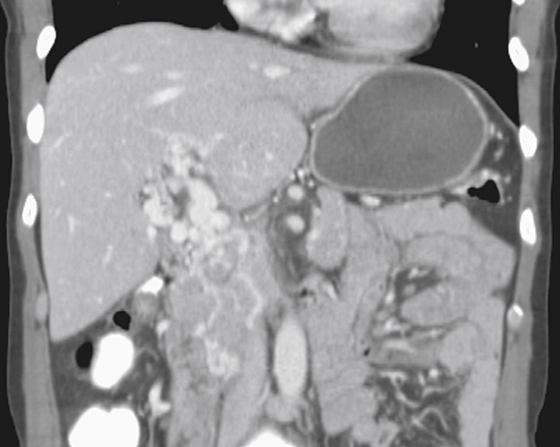CASE 169

History: A 69-year-old man presents with hematemesis.
1. What should be included in the differential diagnosis of the imaging finding shown in the figure? (Choose all that apply.)
A. Cavernous transformation of the portal vein
B. Hepatoportal arteriovenous malformation
C. Hemangioma of the portal vein
D. Aneurysm of the portal vein
E. Agenesis of the portal vein
2. What is the most common cause of portal vein thrombosis in adults?
3. What is the specific feature of portal venous obstruction that results in cavernous transformation?
4. What radiologic intervention has been associated with this condition?
A. Transjugular intrahepatic portosystemic shunting
B. Percutaneous transhepatic cholangiography
C. Transfemoral hepatic arteriography
ANSWERS
CASE 169
Cavernous Transformation of the Portal Vein
1. A, B, C, and E
2. A
3. C
4. A
References
Gallego C, Velasco M, Marcuello P, et al: Congenital and acquired anomalies of the portal venous system. Radiographics. 2002;22(1):141–159.
Cross-Reference
Gastrointestinal Imaging: THE REQUISITES, 3rd ed, p 185.
Comment
Cavernous transformation of the portal venous system is defined as the formation of numerous serpiginous, wormlike venous channels between the liver and spleen as a result of chronic portal vein occlusion. This condition is usually due to portal vein thrombosis. The occlusive process is usually not acute, and some time is required to allow formation of prominent venous collateralization.
Not all cases of portal vein thrombosis result in cavernous transformation. It has been reported in cases of chronic portal hypertension secondary to fibrosing liver disease, chronic pancreatitis, pancreatic carcinoma, hepatocellular carcinoma, perinatal omphalitis in newborns, pregnancy, hemolytic anemias such as thalassemia, hypercoagulable diseases, and systemic sepsis. It can also progress to such conditions as esophageal varices and gastric varices and gastrointestinal bleeding. The diagnosis of both portal vein thrombosis and cavernous transformation can usually be made using Doppler ultrasound. CT can also show these changes and show the underlying cause in some instances (see the figure).







